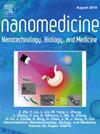过氧化物酶修饰驱动水飞蓟素脂质体治疗肝纤维化
IF 4.6
2区 医学
Q2 MEDICINE, RESEARCH & EXPERIMENTAL
Nanomedicine : nanotechnology, biology, and medicine
Pub Date : 2025-08-19
DOI:10.1016/j.nano.2025.102851
引用次数: 0
摘要
肝纤维化以细胞外基质(ECM)过度沉积为特征,是慢性肝病的关键病理过程。持续氧化应激(OS)主要由高水平的活性氧(ROS)引起,可直接激活肝星状细胞,诱导肝细胞凋亡并引发炎症反应。用过氧化氢酶(CAT)修饰水飞蓟素(SIL)脂质体表面以治疗肝纤维化。CAT是一种内源性抗氧化酶,主要负责去除氧化应激产生的过氧化氢。SIL是一种传统的肝脏保护膳食补充剂。体外实验表明,CAT-LP对正常肝细胞(L-02细胞)具有较低的细胞毒性,可被肝星状细胞(JS1细胞)有效吸收,诱导凋亡。此外,CAT-LP通过清除ROS有效缓解TGF-β诱导的氧化应激,且在富含H₂O₂的环境中释放更完全。体内实验表明,CAT-LP处理显著降低了丙二醛(MDA)和转氨酶(ALT和AST)水平,增加了超氧化物歧化酶(T-SOD)含量,减少了III型前胶原的分泌和沉积。综上所述,CAT和SIL联用通过抑制ros介导的作用,通过保肝药物的协同作用,有效改善小鼠肝纤维化。本文章由计算机程序翻译,如有差异,请以英文原文为准。

Peroxidase modification-driven silymarin liposomes for the treatment of liver fibrosis
Liver fibrosis, characterized by excessive deposition of extracellular matrix (ECM), is a key pathological process in chronic liver disease. Persistent oxidative stress (OS), primarily caused by high levels of reactive oxygen species (ROS), can directly activate hepatic stellate cells, induce hepatocyte apoptosis and trigger inflammatory responses. We modified the surface of silymarin (SIL)-carrying liposomes with catalase (CAT) to treat liver fibrosis. CAT is an endogenous antioxidant enzyme that is primarily responsible for removing hydrogen peroxide generated by oxidative stress. SIL is a traditional liver-protective dietary supplement. In vitro experiments showed that CAT-LP exhibited low cytotoxicity towards normal hepatocytes (L-02 cells) and could be effectively taken up by hepatic stellate cells (JS1 cells), inducing apoptosis. Additionally, CAT-LP effectively alleviated TGF-β-induced oxidative stress by scavenging ROS, demonstrating more complete release in an H₂O₂-enriched environment. In vivo experiments revealed that CAT-LP treatment significantly reduced malondialdehyde (MDA) and transaminase (ALT and AST) levels, increased superoxide dismutase (T-SOD) content and reduced the secretion and deposition of type III procollagen. In summary, combining CAT and SIL effectively improved liver fibrosis in mice by inhibiting ROS-mediated effects and through the synergistic action of hepatoprotective drugs.
求助全文
通过发布文献求助,成功后即可免费获取论文全文。
去求助
来源期刊
CiteScore
11.10
自引率
0.00%
发文量
133
审稿时长
42 days
期刊介绍:
The mission of Nanomedicine: Nanotechnology, Biology, and Medicine (Nanomedicine: NBM) is to promote the emerging interdisciplinary field of nanomedicine.
Nanomedicine: NBM is an international, peer-reviewed journal presenting novel, significant, and interdisciplinary theoretical and experimental results related to nanoscience and nanotechnology in the life and health sciences. Content includes basic, translational, and clinical research addressing diagnosis, treatment, monitoring, prediction, and prevention of diseases.

 求助内容:
求助内容: 应助结果提醒方式:
应助结果提醒方式:


